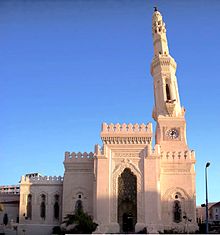Azarita
Azarita الأزاريطة | |
|---|---|
| Coordinates: 31°12′22″N 29°54′53″E / 31.206121°N 29.914813°E | |
| Country | |
| Governorate | |
| Time zone | UTC+2 (EST) |
Azarita (Arabic: الأزاريطة) is a neighborhood in Alexandria, Egypt. It's one of the oldest neighborhoods in Alexandria. It is located within the scope of the Central Alexandria district where Roman art appears in ancient Roman and Greek construction, which is found throughout Alexandria, especially in central parts, which is largely represented by the Azarita district.[1]


History
The history of the establishment of the Azarita district dates back to the period of “Muhammad Ali Pasha,” the ruler of Egypt, who wanted to develop the city of Alexandria, so he established a health council there. However, after the spread of cholera, he thought about introducing the quarantine system in force in Europe so he combined The consuls of the countries and formed a committee, after which a decision was issued to establish the first health quarantine located next to the eastern port where ships of European and foreign communities dock. It was called “Lazarette” in reference to the first health quarry built in France on the island of Sainte-Marie-de-Nazaré, where people from the East used to come and established this Quarantine as a form of health care. This place (the quarantine place) is currently occupied by the main university hospital (the Amiri Hospital). The word "Lazarette" is of Latin origin and means "Ladre", meaning the leper. The western countries used to exaggerate the quarantine on lepers, so they would put them in quarantine for their entire lives. From that word, the word "Azarita" was derived.[1]
Notable People
The Azarita neighborhood witnessed the presence of great historical figures, including:
- Plato is the most famous Greek philosopher.
- Archimedes the famous naturalist and mathematician.
- The famous Alexandrian philosopher Hypatia.
- International director Youssef Chahine.
- Greek singer Demis Roussos.
- Singer Mustafa Qamar.
See also
References

